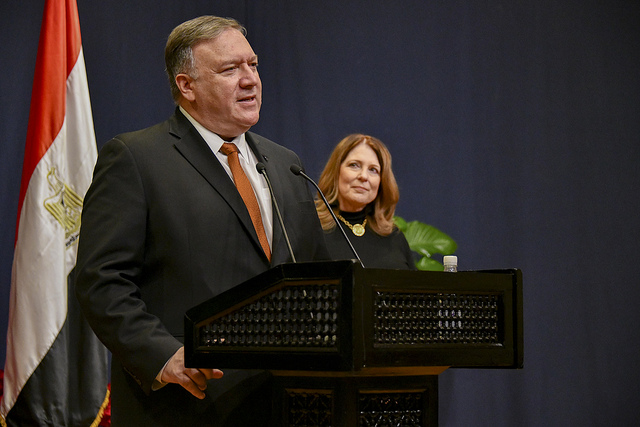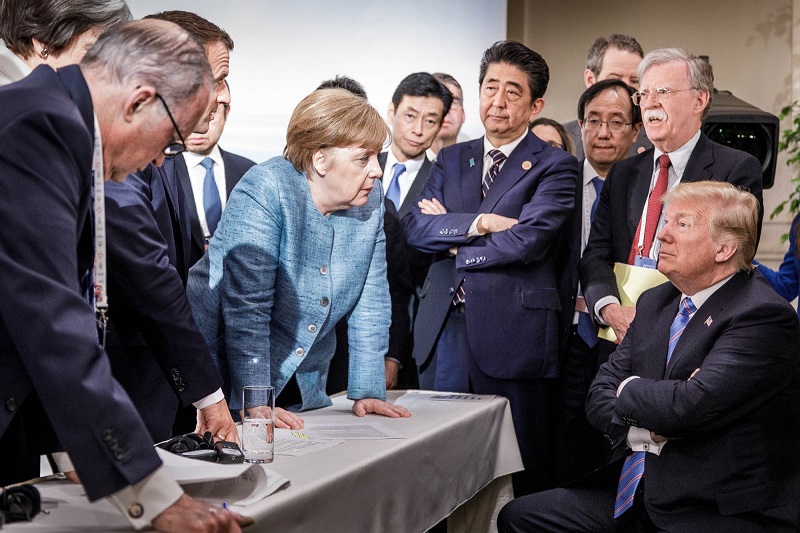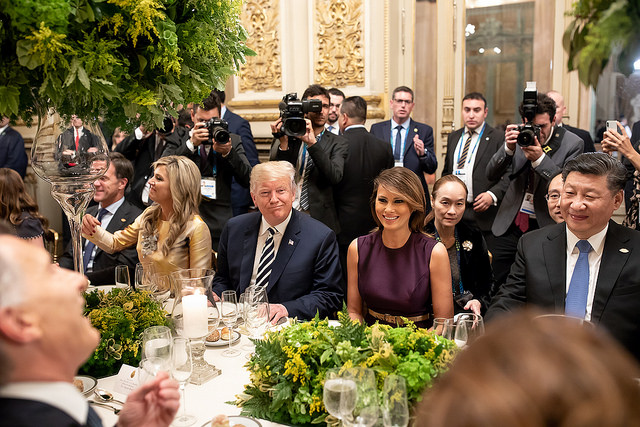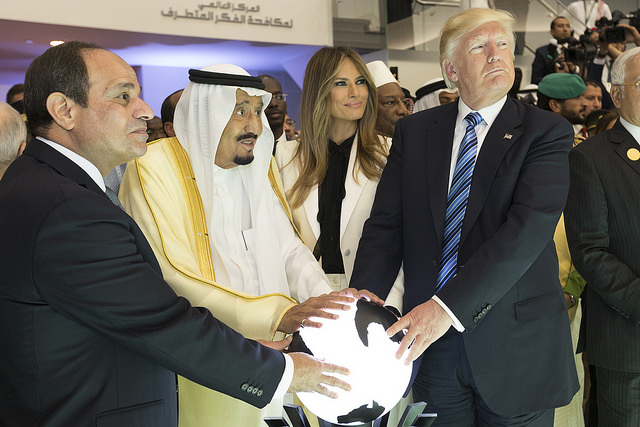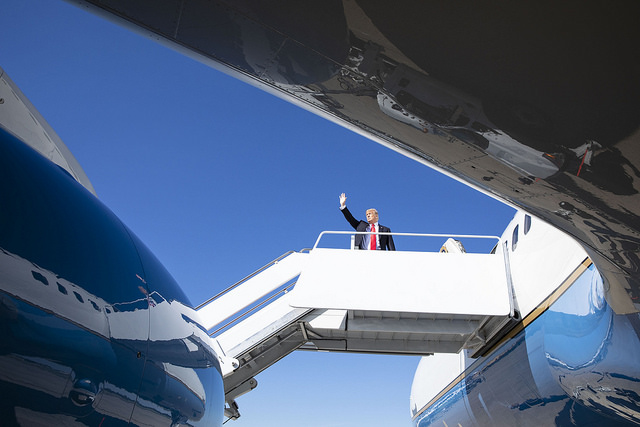
The editors of The Strategist are pleased to present this extract from the first issue of a new ASPI publication series, ‘The Strategist Selections’, released today. Issue 1, ‘Kim Beazley on the US alliance and Australia’s defence and international security’, is a compilation of 24 posts written by Beazley between March 2016 and May 2018. Reproduced below is the volume’s previously unpublished afterword.
It’s now clear that the strategic context underpinning Australian defence policy as set out in the 2016 defence white paper requires reassessment. That’s a product less of a change in the behaviour of those identified as disruptors of the global system (notably, Russia and China) than of the directions of our principal ally under President Donald Trump.
DWP 2016 summed up our strategic circumstances:
[The United States] will continue to be Australia’s most important strategic partner through our long-standing alliance, and the active presence of the United States will continue to underpin the stability of our region. The global strategic and economic weight of the United States will be essential to the continued stability of the rules-based global order on which Australia relies for our security and prosperity. The world will continue to look to the United States for leadership in global security affairs and to lead military coalitions that support international security and the rules-based global order. The United States is committed to sustaining and advancing its military superiority in the 21st century, including through its Defense Innovation Initiative.
Based on these calculations about our ally, the government decided to assign military support for upholding the rules-based order and building confidence in our region equal status with the defence of our approaches as a force structure determinant for the ADF. The assessment acknowledged that two great powers (namely, China and Russia) were contesting that order globally and regionally. It also acknowledged that the burgeoning military capabilities of both powers intensified the challenge for the Americans and for us. However, it judged that the objectives we see as critical to the peace, prosperity and sovereign rights of all states in our region—and therefore the challenges—should be met, working within the structures that emerged in the aftermath of World War II.
As the second year of the Trump administration concludes, it’s clear that our assumptions about American leadership and objectives need to be revised. Liberal internationalism is subordinate to Trump’s intensely nationalist vision. He perceives allies as users and economic competitors. He admires old adversaries with authoritarian tendencies as collaborators, and as potentially more reliable than old allies. He sees the global order’s trading rules as fundamentally inimical to American interests.
July 2018 was a seminal month in the rolling out of these approaches. In Brussels for the NATO summit, Trump criticised and humiliated traditional friends and allies. He questioned their alliance commitments, alluding to NATO members’ pledge to lift defence expenditure to 2% of GDP (an old US demand), but denouncing previously agreed timelines and shifting the goalposts to 4%. Blandishments for friends. Bouquets for adversaries. In Helsinki, Vladimir Putin was feted by Trump. Little is known of their private conversation, but it was evident there was no hard talk on the many points of difference between Russia and the US.
That this would be likely was evident in Trump’s pre–Putin meeting tweet: ‘Our relationship with Russia has NEVER been worse thanks to many years of US foolishness and stupidity and now, the Rigged Witch Hunt!’ His demeanour at the press conference afterwards displayed a level of obsequiousness to the Russian leader unparalleled at such presidential encounters.
With suspicions mounting about the basis of Trump’s fears of the Mueller investigation and his past financial and personal associations with Russia, former director of national intelligence James Clapper reflected the tone of post–press conference commentary and bipartisan anxiety. He told CNN:
I think this past weekend is illustrative of what a great case officer Vladimir Putin is. He knows how to handle an asset, and that’s what he is doing with the president … [Y]ou have to remember Putin’s background. He’s a KGB officer. That’s what they do. They recruit assets. And I think some of that experience and instincts of Putin has come into play here in his managing of a pretty important account for him, if I could use that term, with our president.
Issues of Trump’s alleged venality and allegiance are matters for US domestic politics. What focuses NATO members is the president’s repeated calling into question of Washington’s support in situations involving the collective military response mandated in Article 5 of the NATO Charter. In the past two years, Japan and South Korea have had similar concerns with their agreements as the president has worked his approaches to North Korea’s nuclear disarmament. Trust has been further eroded by America’s recent trade assault on allies; their experience isn’t much different from that of an adversary and serial offender of at least the spirit of World Trade Organization rules (for example, China, on intellectual property related matters).
Trump’s approaches to trade and to recalibrating relations with Russia and North Korea have lacked coherence. The resulting confusion has allowed allies to seek friends in the administration. State Department, Defense Department and intelligence officials have produced reassurances and signed up to policy pronouncements reflective of the old order. The communiqué of the NATO meeting covered the Russian disagreements in traditional fashion with the US signed on. Defense Secretary Jim Mattis’s national defence strategy elevated Russia and China to once again being the main adversaries, displacing counterterrorism from the top spot.
The NDS was a ringing endorsement of the old alliance systems. It assigned those partnerships even greater importance in an era in which old adversaries were attributed more significance and approached parity in capability. What these contradictions mean is unclear. But what is evident is that nothing can be guaranteed in this muddle. This also raises the possibility that adversaries might probe possible gaps in the multilateral security edifice where responses from the US would be uncertain.
Returning to that quote from DWP 2016 at the beginning of this afterword, the one part that still resonates is the last sentence. The US, it says, will continue to sustain, advance and upgrade its military capabilities. While the rest of the assessment is somewhat frayed, major increases in US defence spending and vigorous technological regeneration now support that judgement.
Australia has evaded Trump’s criticism on the economic and military fronts. No threats have been issued against our guarantees and commitments. However, our careful efforts over the past three decades to engage the US in our region in a way that member states are comfortable with have been massively undermined. This is a region devoted to the rules-based order (China somewhat qualified). US participation in the Trans-Pacific Partnership symbolised our strategy’s and diplomacy’s success. Trump repudiated the work, but America still seems to be committed to the multilateral meetings that are core features of regional diplomacy. A heavy security focus supplants economics.
That’s gratifying to a degree, but given the volatility in US policy, none can be certain what might transpire in a crisis or how the US might react to provocations in the region. A quicker resort to a military response to Chinese activity in the South China Sea, for example, might challenge US allies in an environment where the Americans place a premium on burden-sharing and react harshly to a failure in support.
While the US has stepped back from some regional engagements, a number of its allies and friends, including Australia, have stepped forward to address regional diplomacy more intensively. In the absence of the US, however, China looms large. Australia’s situation is complex. Earlier in this compendium, I argued that our growing dependence on the US in the post–Cold War era has narrowed our options. In the 1980s, given the balance of advantage in the relationship with the US, Australia could push the frozen architecture of the Cold War to its limits and embark on a multiplicity of global and regional initiatives. A low-threat environment, and none that would oblige the US to contemplate its own destruction if it aided us, underpinned this flexibility. In addition, the US was relatively uninvested in the region.
That has now changed. The Indo-Pacific region has been elevated in US priorities and we have witnessed the emergence of economically powerful and increasingly militarily capable nations in our zone. Most importantly for a nation that focuses on a high-technology defence like Australia, only the US, which leads the advance to next-generation weapons, can provide us with the relevant systems in all their complexity.
For us, Trump may be inimical to the values we espouse in support of collective security, liberal internationalism and the rules-based order, even though his words of mutual regard bilaterally have been strong. However, unchallenged by him is the military component of what is fundamentally a military alliance. We are effectively invited by him to put sentiment on a back burner. The communiqués and press conferences from AUSMIN meetings, as evidenced at the most recent on 24 July 2018, still, however, reflect that sentiment. That is another manifestation of the more conventional outlook of Trump’s national security team. Given the rapidly changing character of the distribution of power in our region, it would be wise for us to plan on greater volatility in both US policy and the international politics of the region.
Our focus is now on Trump. His spectacular character overshadows dramatic change in the other major regional player, China. Its internal order has been disrupted too. Deng Xiaoping’s move to collective leadership, constitutionalism and the private sector as economic driver has been superseded. President Xi Jinping has reasserted party control, entrenched state capitalism and redefined China’s maritime borders in a quest for legitimacy. It’s possible that as time goes by and inevitable domestic difficulties arise, expectations will also rise in the Chinese polity that Xi will secure outcomes on Taiwan and military domination of China’s maritime approaches. Much more is expected of time-unlimited authoritarian leaders than of time-limited party committees.
While Xi will likely outlast Trump, it doesn’t require too much imagination to envisage confrontational events in both areas and on the Korean peninsula. He will be expected to resolve the Taiwan problem in particular. Should the US respond—and Trump has been much more supportive of Taiwan than of other friends and allies—it will look to regional friends. Both Trump and Mattis have been more hard-line on the South China Sea than Obama. They will look to us.
In this collection, I have canvassed these changes. The diplomatic and foreign policy responses are obvious and are being pursued. We are using institutions to strengthen confidence-building in the region. That is reflected in concluding the TPP on a regional basis, enhancing Singaporean and Malaysian military collaboration, working on quadrilateral consultations, and reactivating our diplomatic and aid focus on the South Pacific. The defence response is harder and massively more expensive.
The collective response clauses in our treaty arrangements with the US are not the most salient part of the arrangement. We are still realistically focused on being able to handle direct threats ourselves, albeit in the face of rapidly rising technological demands on our capacity. Chinese attitudes aside, our alliance relationship and its military aspect are welcome—or at least not unwelcome—among our regional partners. A decision to persist with the alliance carries little political cost and isn’t directly the object of Trump’s undermining. However, the contemporary era of volatile American decision-making means we will need to recognise that the cost might occasionally involve difficult choices.
The key question lies with our defence force planning. In doing what needs to be done to get the best out of the relationship, two areas stand out. The first is our level of readiness. The second is how best to use the allied relationship to advance our technological capability. Both are heavily affected by available resources. This wouldn’t be such an issue if we had kept defence spending at the level we had in the 1980s—an average of 2.3% of GDP. At that level today, we would spending about $5 billion more on defence each year. We need to get back there.
Readiness calls into question the long lead time on our plans for new equipment and the resources devoted to supplies and ammunition for existing capabilities. We need to give higher priority and more disciplined attention to a strategy of denial in our maritime approaches; upgrade collaboration in the South Pacific neighbourhood in particular; bring a sharper focus to the vulnerabilities of our critical mineral provinces; and rapidly incorporate the ‘fifth generation’ capabilities coming in with the F-35 in systems across the ADF. DWP 2016 made clear that our focus on platforms has been ‘at the expense of funding the vital enabling and integrating systems that allow the ADF to bring capability elements together to deliver more potent and lethal joint combat effects’.
It’s in this area that the technological capabilities the US brings has immediate impact. While formulating the NDS, Mattis pointed out that although adversary capabilities with particular weapons and platforms will often advance ahead of the US (as happened in the Cold War), the US was yet to be bettered in systems of systems. In the longer term, from the Australian point of view, the issue is whether the US will sustain its focus on the technological changes necessary to be competitive and whether we will interact with the US sufficiently to obtain those critical capabilities modified for our own defence purposes.
There’s a refreshing humility around American decision-makers at the moment on these matters. While Mattis’s NDS doesn’t mention the ‘third offset strategy’, it is intense on competition in next-generation capabilities. The notion of the third offset, like the first and second, was based on the assumption that the US would jump ahead. Former deputy defence secretary Bob Work said recently:
I actually regret talking about the Third Offset Strategy, in hindsight. It made it sound like we had the advantage and we had time to think about it and go through the motions … I wish I would have said, ‘we need to start about upsetting the Chinese offset, which is coming uncomfortably close to achieving technological parity with the US’ … It’s time for the US to crack the whip.
The competition, however, has been transformed, at least over the next four years, by the surge in America’s defence budget. At US$714 billion (up from US$609 billion) a year, it compares with China’s US$228.2 billion and Russia’s US$66.3 billion defence budgets. It is arguable that Russia has poked the US into an arms race on nuclear capabilities, artificial intelligence, and hypersonic and directed-energy weapons that it doesn’t have the resources to win. Journalist Paul McCleary pointed out in May that Senate Armed Services Committee members saw some mismatch between the new national strategy and the amount of funding requested by the White House. In their view, there was not enough focus on the strategic competition with China and Russia. Over the months, that has been much modified, and there’s still argument over what many regard as a misdirected focus on the additional naval platforms and army troops which Trump is keen on. What the armed services want is a focus on the new capabilities. The senate committee has finalised the budget with extra funds for hypersonics, directed-energy weapons, quantum information sciences, space constellation efforts, and rocket propulsion.
It’s clear from the close relationship forged over the years with Australian defence science, defence forces and defence intelligence that industry now has something to latch onto. At the July AUSMIN meeting, Mattis emphasised Australia’s inclusion earlier this year in the US national technology and industrial base as an enabler. This now facilitates defence integration and coordination between the US, Canada, Australia and the UK. Brendan Thomas-Noone in his seminal paper, Mapping the third offset, has pointed out how Australia might leverage this into participation in the Pentagon Defence Innovation Unit Experimental (DIUx), a mechanism for a shared meeting of these technological challenges that engages our private sector.
Australia is already involved in joint development in electronic warfare, hypersonics, directed-energy weapons and satellite constellations, among an array of technological research and development projects. Previous AUSMINs led to two new joint facilities focused on space situational awareness. The last one resulted in a memorandum of understanding on ‘critical research and development of advanced cyber capabilities’. Hand-wringing over whether we should change course in our relations with the US is overwhelmed by the intensity of the intelligence engagement and Australia’s embedding in American next-generation technologies. That intensity is matched by mutual investment in the private sector, which now stands at around A$1.5 trillion.
What this means is that Australia should be able to engage the American diplomatic posture with confidence. We can look after ourselves based on this relationship whatever way the US props, provided we move to a more direct focus on our approaches (or as we used to say, ‘our area of direct military interest’) in how we base our defence assumptions in the shifting strategic environment.
The US and the region are not as they were when core calculations were made in DWP 2016 for the strategic basis of our defence planning. The way things have changed since 2016 demands that we simplify our priorities. The emerging strategic order also requires, paradoxically, an even deeper engagement with our disruptive ally.




